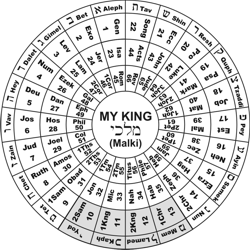Alphabetic Integration
with the History of the Kingdom
Yet have I set my king (malki) upon my holy hill of Zion. I will declare the
decree: the LORD hath said unto me, Thou art my Son; this day have I begotten thee.
Psalm 2:6f

The word translated as "my king" in the
verse above is malki, formed from the standard Hebrew
word for a king (melek) suffixed with a Yod to indicate personal possession. This is an example of the
self-reflective coherence characteristic of the Hebrew language. As discussed in Chapter 6 of the Bible Wheel book,
Hebrew is a building-block language where the meanings of the Letters carry over into the meanings
of the words they form. The Letter Yod denotes a hand, the member of the body by which we g.php
and control things, and so it is suffixed as a symbol of personal possession (BW book pg 113).
The word malki is formed from four sequential Letters that lie at the exact center of
the Alphabet – Yod, Kaph, Lamed, Mem – read in reverse order (recall Hebrew is read from right to left).
They span the following Books on Cycle 1:


If ever there were a sign of
Divine design, this is it. The Hebrew name of the
two central Books – Melakim (Kings) – is itself the plural of melek, the very word spelt
by the alphabetic sequence! Furthermore, these four Books span the reign of all the kings
of Israel and Judah except Saul who was explicitly rejected as king by the Lord Himself
(1 Sam 15:26, BW book pg 225). King David, called by God "my king" in Psalm 2:6 in
prophetic anticipation of His Son, completely dominates the first and last of these four Books.
His ascension to the throne and subsequent forty-year reign is the sole subject of 2 Samuel,
and after ten chapters of genealogies, 1 Chronicles devotes its remaining nineteen chapters
entirely to the reign of King David, closing with his death. We have, therefore, an
exact correspondence of the content of these four Books and their placement in the Christian Canon
with the pattern eternally established by God in the sequence of the Hebrew Alphabet. Simply
stated, God designed the Wheel to be self-descriptive.

Yet there is, as always,
more, ever more! The blazing glory of God's revelation knows no limit. The graph shows the
distribution of melek on Cycle 1. Exactly as should be expected, the Books describing the kings
themselves contain the greatest frequency of the word "king." The distribution follows the
rise and fall of the Davidic Kingdom. It mimics a bell curve that is both maximized and
centered on Spoke 12, corresponding to the Lamed at the exact center of the word melek,
highlighted on the x-axis. It is really important to sit back at this point and ponder what is
going on here. We are witnessing a standing miracle; the self-descriptive and
self-coherent design of the order and content of the Books of the Bible
upon the pattern of the Hebrew Alphabet.
God reiterated the thematic pattern of the central books on Cycle 1
in the four middle letters
of the alphabetically structured Psalm 145. The Mem KeyWord malkuth (kingdom), based on melek (king), is found only in
the verses corresponding to Mem, Lamed, and Kaph, the very letters which spell melek!.
I include the verse corresponding to Yod for context. The hyperlinked words are the corresponding Alphabetic
KeyWords. The Mem KeyWord in verse 13 is the word malkuth itself.
| Central Alphabetic Sequence of AV Psalm 145 |
| י |
10 - Yod |
All thy works shall praise (yadah) thee,
O LORD; and thy saints shall bless thee. |
| כ |
11 - Kaph |
They shall speak of the glory (kavod) of thy
KINGDOM (malkuth), and talk of thy power; |
| ל |
12 - Lamed |
To make known (l'hodia) to the sons of
men his mighty acts, and the glorious majesty of his KINGDOM (malkuth). |
| מ |
13 - Mem |
Thy KINGDOM (malkuth) is an everlasting KINGDOM (malkuth), and thy
dominion endureth throughout all generations. |
The integration here is truly astounding. Not only are the symbolic meanings of these letters
fully integrated with the content of their corresponding books on the Wheel, but they also combine
to form the meaning of the Hebrew word melek, and they do so in a way that has been understood
for millenia in the rabbinic tradition! Here is how Rabbi Munk put it in his book
Wisdom of the Hebrew Alphabet  (pg 138).
[References to the Bible Wheel book are added in square brackets]: (pg 138).
[References to the Bible Wheel book are added in square brackets]:
The ל (Lamed) is a majestic Letter, towering above the other Letters from
its position in the center of the Alphabet. Thus it symbolizes the King of Kings, the Supreme Ruler
[Spoke 12, BW book pg 247].
On one side Lamed is flanked by the כ (Kaph) which alludes to the kiseh hakavod,
God's Throne of Glory [Spoke 11, BW book pg 239], while on
its other side stands מ (Mem),
the Attribute of malkuth, God's Kingship [Spoke 13, BW book pg 266].
Together, these three Letters spell Melek (King).
Yet there is still another greater wonder that surpasses all others to be discoverd in this
Alphabetic correlation. When the Spokes of the Wheel are taken as representing centuries both
before and after Christ, the rise and fall of the Two Kingdoms - that of Israel (ca. 1000 BC) and
that of the Holy Roman Empire (ca. 1000 AD) - both align with the word malki at the center
of the Alphabet! This is discussed in Aleph Tav: The Key to the Kingdoms.
|




 (pg 138).
[References to the Bible Wheel book are added in square brackets]:
(pg 138).
[References to the Bible Wheel book are added in square brackets]: